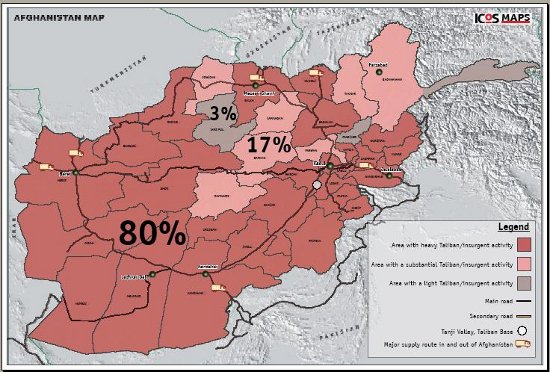|
|
|
The ICOS’ meaningless map on Taliban presence in Afghanistan. |
The latest report by the The International Council on Security and Development on the security situation in Afghanistan is making plenty of waves. According to the report, 97 percent of Afghansitan is infested with the Taliban.
The Taliban now have a permanent presence in 80% of Afghanistan, up from 72% in November 2008, according to a new map released today by the International Council on Security and Development (ICOS). According to ICOS, another 17% of Afghanistan is seeing ‘substantial’ Taliban activity. Taken together, these figures show that the Taliban has a significant presence in virtually all of Afghanistan.
But when you look a little more closely at how the ICOS determines if a province has a permanent or significant Taliban presence, the standards are so low as to be almost meaningless:
Permanent presence: defined by provinces that average one (or more) insurgent attack (lethal and non-lethal) per week.
Substantial presence: an average one or more insurgent attacks per month and include residents who believe Taliban are active locally (based on frequency of Taliban sightings).
Light presence: defined by less than one insurgent attack per month and local residents don’t believe Taliban is active locally (based on frequency of Taliban sightings). To calculate percentages, the total area of Afghanistan was divided by the total area hosting a permanent/substantial/light Taliban presence.
There is little doubt that the security situation in Afghanistan is in decline. But the ICOS’ ratings tell us little about the security problems that exist in Afghanistan.
If you want to know about the level of Taliban presence, it makes more sense to break out the country by districts. And you need to look at more than just attacks and sightings. Are the Taliban collecting taxes, running a parallel government, openly recruiting fighters? Are local security forces providing security or are they holed up in district centers? Does the Taliban run the region from dusk until dawn? Do schools remain closed due to Taliban threats? Were the people in the district able to vote in the last election? Etc.
Are you a dedicated reader of FDD's Long War Journal? Has our research benefitted you or your team over the years? Support our independent reporting and analysis today by considering a one-time or monthly donation. Thanks for reading! You can make a tax-deductible donation here.









2 Comments
To see how absurd this report is, just is apply the same analysis to the US.
Where I live (San Fransisco), there are an average of 122 violent crimes per week for a population of 750,000.
In other words, the rate of violent crimes in San Fransisco is 160 times higher than the definition of “permenent presence” in Afghanistan.
1.) THERE IS NO WAY TO SEPARATE CRIMINAL ACTIVITY FROM INSURGENT ACTIVITY.
2.) A NIGHT LETTER (A THREATENING NOTE) IS CONSIDERED A TERRORIST INCIDENT.
3.) WHY THE SURPRISE THEY ARE MOVING INTO NEW AREAS?
AS THE TALIBAN ARE FORCED OUT OF ONE AREA, THEY MOVE INTO OTHER AREAS WITH LESS AFGHAN ARMY AND INTERNATIONAL PRESENCE.
THEY ARE FLUID LIKE WATER THEY WILL TAKE THE PATH OF LEAST RESISTANCE.
BUT THEY ALSO ARE NOT CAPABLE OF ESTABLISHING A PERMANENT HOLD ON THE NEW AREAS.
4.) USING THE SAME CRITERIA I WOULD LIKE TO SEE THE REPORT ON IRAQ TO COMPARE IT TO AFGHANISTAN.
5.) USING THE SAME CRITERIA I WOULD LIKE TO SEE THE REPORT ON EACH STATE IN THE USA. SEVERAL WOULD BE UNDER INSURGENT PERMANENT PRESENCE.